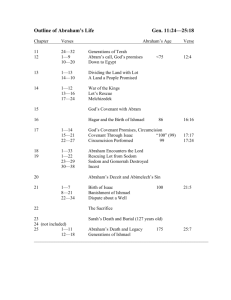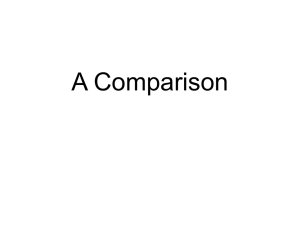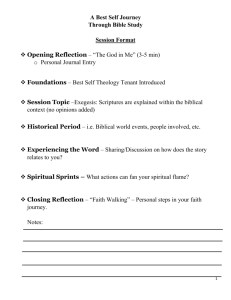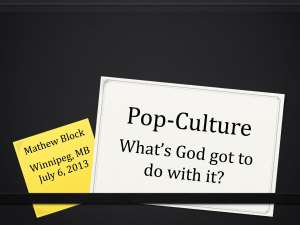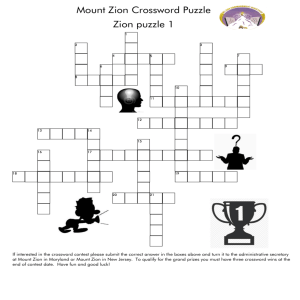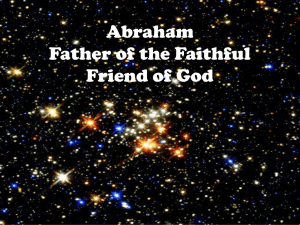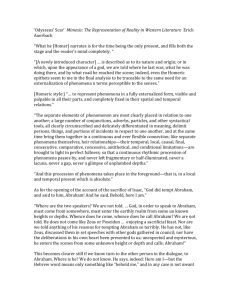Filipova Snezana The Sacrifice of abraham from bargala'S wooden
advertisement
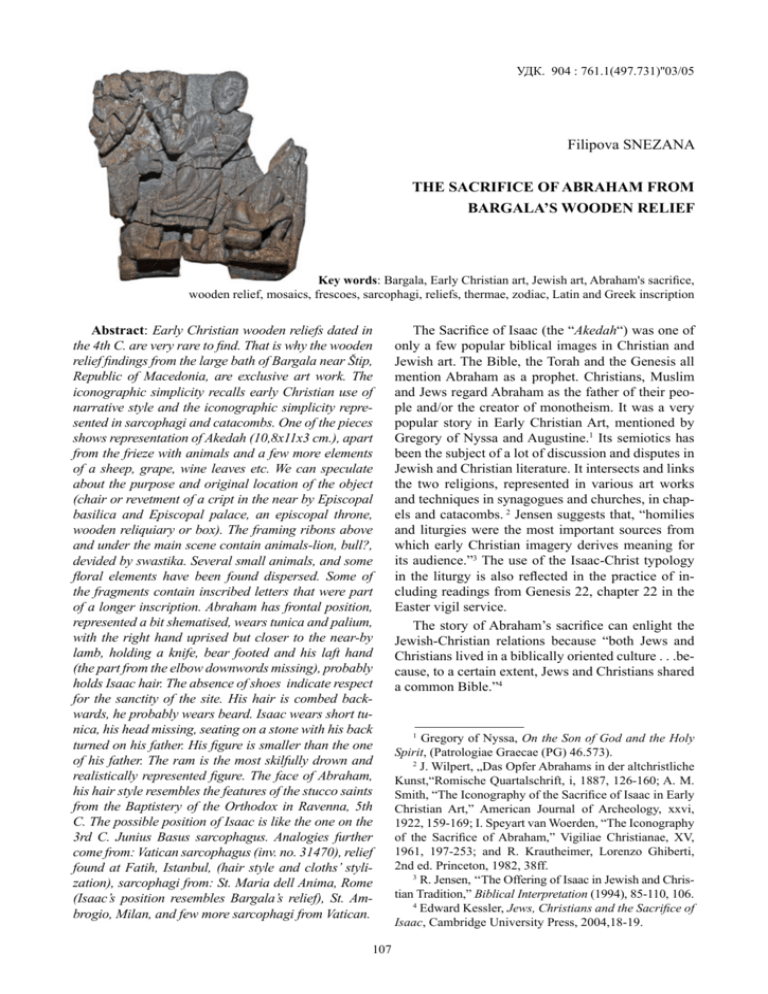
УДК. 904 : 761.1(497.731)''03/05 Filipova Snezana The Sacrifice of Abraham from Bargala’s wooden relief Key words: Bargala, Early Christian art, Jewish art, Abraham's sacrifice, wooden relief, mosaics, frescoes, sarcophagi, reliefs, thermae, zodiac, Latin and Greek inscription Abstract: Early Christian wooden reliefs dated in the 4th C. are very rare to find. That is why the wooden relief findings from the large bath of Bargala near Štip, Republic of Macedonia, are exclusive art work. The iconographic simplicity recalls early Christian use of narrative style and the iconographic simplicity represented in sarcophagi and catacombs. One of the pieces shows representation of Akedah (10,8x11x3 cm.), apart from the frieze with animals and a few more elements of a sheep, grape, wine leaves etc. We can speculate about the purpose and original location of the object (chair or revetment of a cript in the near by Episcopal basilica and Episcopal palace, an episcopal throne, wooden reliquiary or box). The framing ribons above and under the main scene contain animals-lion, bull?, devided by swastika. Several small animals, and some floral elements have been found dispersed. Some of the fragments contain inscribed letters that were part of a longer inscription. Abraham has frontal position, represented a bit shematised, wears tunica and palium, with the right hand uprised but closer to the near-by lamb, holding a knife, bear footed and his laft hand (the part from the elbow downwords missing), probably holds Isaac hair. The absence of shoes indicate respect for the sanctity of the site. His hair is combed backwards, he probably wears beard. Isaac wears short tunica, his head missing, seating on a stone with his back turned on his father. His figure is smaller than the one of his father. The ram is the most skilfully drown and realistically represented figure. The face of Abraham, his hair style resembles the features of the stucco saints from the Baptistery of the Orthodox in Ravenna, 5th C. The possible position of Isaac is like the one on the 3rd C. Junius Basus sarcophagus. Analogies further come from: Vatican sarcophagus (inv. no. 31470), relief found at Fatih, Istanbul, (hair style and cloths’ stylization), sarcophagi from: St. Maria dell Anima, Rome (Isaac’s position resembles Bargala’s relief), St. Ambrogio, Milan, and few more sarcophagi from Vatican. 107 The Sacrifice of Isaac (the “Akedah“) was one of only a few popular biblical images in Christian and Jewish art. The Bible, the Torah and the Genesis all mention Abraham as a prophet. Christians, Muslim and Jews regard Abraham as the father of their people and/or the creator of monotheism. It was a very popular story in Early Christian Art, mentioned by Gregory of Nyssa and Augustine.1 Its semiotics has been the subject of a lot of discussion and disputes in Jewish and Christian literature. It intersects and links the two religions, represented in various art works and techniques in synagogues and churches, in chapels and catacombs. 2 Jensen suggests that, “homilies and liturgies were the most important sources from which early Christian imagery derives meaning for its audience.”3 The use of the Isaac-Christ typology in the liturgy is also reflected in the practice of including readings from Genesis 22, chapter 22 in the Easter vigil service. The story of Abraham’s sacrifice can enlight the Jewish-Christian relations because “both Jews and Christians lived in a biblically oriented culture . . .because, to a certain extent, Jews and Christians shared a common Bible.”4 Gregory of Nyssa, On the Son of God and the Holy Spirit, (Patrologiae Graecae (PG) 46.573). 2 J. Wilpert, „Das Opfer Abrahams in der altchristliche Kunst,“Romische Quartalschrift, i, 1887, 126-160; A. M. Smith, “The Iconography of the Sacrifice of Isaac in Early Christian Art,” American Journal of Archeology, xxvi, 1922, 159-169; I. Speyart van Woerden, “The Iconography of the Sacrifice of Abraham,” Vigiliae Christianae, xv, 1961, 197-253; and R. Krautheimer, Lorenzo Ghiberti, 2nd ed. Princeton, 1982, 38ff. 3 R. Jensen, ‘‘The Offering of Isaac in Jewish and Christian Tradition,” Biblical Interpretation (1994), 85-110, 106. 4 Edward Kessler, Jews, Christians and the Sacrifice of Isaac, Cambridge University Press, 2004,18-19. 1 fig. 1. Part of the large thermae in Bargala, near Štip, the open space where the relief was found, at the time of discovery fig. 2. The Large thermae in Bargala, the open space where the relief was found, present situation Kessler and Bregman argue that visualisation of the theme shall receive much more attention than the interpretation of the textual sources. “An understanding of artistic interpretation has generally begun with the word but should begin with the image.”5 Kessler suggests it is also true for the Christian and Jewish studies of the artistic portrayal of the Akedah. He suggests the first stage should be to examine the image on its own; the second is with reference to the biblical story; the third is with reference to the literary context. “Like the rabbis, the church fathers were concerned about the idolatrous nature of art in places of worship, but they were not as hostile to art as was originally assumed. For example, Tertullian like Rab- ban Gamaliel II states that figurative representation was not forbidden because it was not idolatrous.” 6 After St. Paul’s letter to the Hebrews, 11:17, The Sacrifice of Isaac in literature was sometimes interpreted as a metaphor of prefiguration of the mysteries instituted by the era of Christ and the Church7. Isaac was related to Christ and associated to the Road to Calvary because of the pre-sacrificial preparations in which Isaac carried the wood of his own immolation on his back (Christian reading of Genesis 22). This sacrifice is seen as prototype of Christ sacrifice on By faith Abraham, when he was tried, offered up Isaac; and he that had received the promises offered up his only begotten son, of who it was said, that in Isaac shall thy seed be called; accounting that god was able to raise him up, even from the dead; from whence also he received him in a figure. Hebrews 11:17 8 Jeffrey Spier with contributions by Jensen et alles, (Jensen, “Early Christian Images and Exegesis”), exhibi7 Edward Kessler, A Response to Marc Bregman, Journal of Textual Reasoning, http://jtr.lib.virginia.edu/ volume-2-number-1/response-to-marc-bregman/. 6 Idem. 5 108 fig. 3. All the fragments of the wooden relief exhibited in the Museum and Gallery Štip the Cross already around year 200 by Melito, bishop of Sardis.8 Jewish tradition identified Mount Moriah with the Temple Mount. An anonymous pilgrim from the 6th century known as the Piacenza Pilgrim described Golgotha in the following way: “You can see the place where [Jesus] was crucified, and on the actual rock there is a bloodstain. Beside this is the altar of Abraham, which is where he intended to offer Isaac, and where Melchizedek offered sacrifice.” 9 Western Hellenistic, Asiatic-Hellenistic or Jewish iconographical type of the scene of Akedah In time the iconography of the Sacrifice of Isaac differed, as it happens with most of the themes. Generally there were motifs specifically associated with two basic types, Latin or Hellenistic (sometimes named Greek, that is Byzantine) iconographic types. The typology concerning this scene suggested by Alison Moore Smith in the early thirties of the 20th C. seems to be still in use.10 She describes the scene of Akedah filled with the Hellenistic tradition of simplicity and lack of realism. In the Hellenistic iconographical type Abraham wears either tunic and pallium or exomis. Usually he is bearded. Holding the knife in his right hand, with his left he often grasps tion catalogue, Picturing the Bible: The Earliest Christian Art,” Jale University Press, 2007, 65-85, 9 C. Milani, Itinerarium Antonini Placentini. Un viaggio in Terra Santa dal 560-570 d.C. (A journey to the Holy Land from 560 to 570 AD), Milan, 1977, 238. 10 A. M. Smith, „The Iconography of the Sacrifice of Isaac in Early Christian Art,“ American Journal of Archeology, xxvi, 1922, 159-169. 109 the head of Isaac who kneels on the ground or stands beside the lighted box-shaped altar with hands shackled as Christ’s were in the apocryphal version of the Crucifixion. Frequently the Hand of God is introduced, in which case Abraham turns his head towards Him and the ram is almost invariably present. In the Asiatic-Hellenistic Type Abraham always wears long draperies. He grasps the knife with his right hand and turns his face towards the Hand of God emerging from above which is an omnipresent detail. Sometimes his left hand rests upon Isaac’s head. The presence or absence of ram and tree are not significant variations as in the Hellenistic type. The detail which differentiates the Asiatic-Hellenistic from the western Hellenistic representations is that Isaac is always on the altar instead of standing or kneeling on the ground; the representation that follows the literary source usually found in Eastern iconography, the posait eum (Isaac) in altare of Gen. XXII.11 In the case of Bargala, the altar if it existed is missing, but it is visible Isaac is seated and it is rather less probable his head was put on an altar. It is much more probable according to the possible length of his arm, Abraham holds Isaac’ hair (fig. 3 b). Sources for the images There was mutual interchange of influences between Jewish and Christian culture, but little attention has been given to the question of the influence of Christianity upon Judaism. Kessler provides an Smith, „The Iconography of the Sacrifice of Isaac in Early Christian Art,“ 161, 163. 11 fig. 4. The composition of Abraham sacrifice insight into the point of mutual influences and intersection of this two-way encounter and argues that neither Jewish nor Christian interpretations can be understood properly without reference to the other. “Jews and Christians share not only common biblical texts, but also common exegetical tradition”.12 Isaac Kalimi in his review of Kessler book13 disputes Kessler starting point that”Jews and Christians share a sacred text: they are bound together by the Bible.” He inquires if they also share a common exegetical tradition that is the Old Testament. Kalimi thinks the very common texts of Hebrew Bible/Old Testament generally are not used as a starting point for better mutual understanding and acceptance of each other; on the contrary, they deepened the dispute, animosity, and conflict between the sister religions over thousands of years. the Callixtus catacomb in Rome. Abraham and the child Isaac are offering thanks for their deliverance. In the foreground, to their right stands the ram. Late 3rd C. fresco located in the Catacomb of Priscilla, Rome (fig. 4) shows the boy Isaac carrying wood and Abraham pointing to the fire on an altar or perhaps to a tree. Abraham is looking up to the heavens. Two other 4th C. frescoes have very similar images. In the Catacomb of Peter and Marcellinus (fig. 5) Abraham holds a knife in his raised right hand and at his feet is the child Isaac - naked, kneeling and bound for the sacrifice. The ram is far aside of the altar. Cubiculum C in the Via Latina (late 4th C.) represents the same iconography: the altar has wood burning upon it; to the left is the ram, Abraham has a sword in his hand, looking at something, while Isaac is kneeling with his hands behind his back. Below is a representation of a servant with a donkey. Stemberger thinks their iconography is under Jewish influence and that is a proof for the peaceful coexistence of Jews and Christians. Outside Rome there is a 4th C. painting from Egypt, Karge, chapel Myra. Comparison with the Sacrifice on Golgotha is found in the liturgical texts. The ram is significant in artistic interpretation because of its allusion to deliverance. Typology is rarely found in artistic interpretation during this period, and when it is found it is asso- Works of art depicting the Sacrifice of Isaac The early Christian artistic interpretations of the Sacrifice of Isaac illustrate deliverance (sometimes referring to the Eucharist). Images are found in funereal art because the story was understood in relation to death and resurrection. The earliest catacomb frescoes that illustrate the theme of deliverance, dated in the 3rd C, come from Kessler, Christians and the Sacrifice of Isaac, 184. Published by RBL in 2005 by the Society of Biblical Literature. See http://www.bookreviews.org/subscribe.asp. 12 14 Kessler, A Response to Marc Bregman, Journal of Textual Reasoning volume II, no. 1, 2003, p. 4. 13 110 fig. 4a. Abraham sacrifice, back site ciated with liturgy, not literature, states Kessler.14 He thinks these examples of catacomb art emphasise the aspect of deliverance, which either parallels, or perhaps even precedes, the early Christian prayer for the dead, which contained a cycle of deliverance. This prayer and its reference to the Sacrifice of Isaac came into use by the 4th century A.D. So artistic interpretation paralleled the liturgical development.15 The text that is referred to when illustrating this composition is Genesis 22:10-13: “And Abraham stretched forth his hand, and took the knife to slay his son. And the angel of the Lord called unto him and said, Abraham, Abraham, and he said, Here am I. And he said, Lay not thine hand upon the lad, neither do thou anything unto him; for now I know that thou fearest God, seeing thou has not withheld thy son, thine only son from me. And Abraham lifted up his eyes and looked and beheld behind him a ram caught in a thicket by his horns; and Abraham went and took the ram and offered him up for a burnt offering instead of his son .” The reading of Genesis 22, like the Jewish liturgical calendar, was an important element of the lectionary cycle and was mentioned by a pilgrim during her visit to Jerusalem in the late fourth century AD. The Easter cycle was the major feature of the liturgical year and Genesis 22 was commonly read on the Thursday before Easter. When the priest extends his hands over the host he prays: “Supra quae propitio ac sereno vultu respicere digneris et accepta habere, sicuti accepta.” Images of the Sacrifice of Isaac are frequent in early Christian sarcophagi, the Mas d’Aire Sarcophagus (3rd C.) being the earliest. It shows the child Isaac, bound and kneeling. Abraham grasps his hair from behind and raises the knife to strike. Abraham’s 15 Ibid., 2. 111 fig. 5. View from above of the fragment with the Abraham's sacrifice scene fig. 5a. Abraham's sacrifice, possible reconstruction of the scene eyes are not on Isaac but the ram, which is standing at his side (almost nuzzling him). The ram appears eager to be sacrificed. The early Christian art rarely shows typology in the details. For example, the sarcophagi examples do not portray the ram caught by its horns or caught in a bush, suggesting that ram was not of christological importance to the artists. Nor do they show Isaac carrying wood as a model of Christ carrying the cross. Many of the sarcophagi show post-biblical interpretation which can not be found in contemporary Christian literature. This may also indicate that artistic interpretations contain traditions, that are otherwise lost.16 16 For example, in a Luc-de-Bearn sixth-century sarcophagus, a man and woman are watching the sacrifice (Sarah?). The appearance of Sarah at the sacrifice is mentioned in the poems of St Ephrem of Syria and other Syriac fig. 6. Fragment of the frieze with lion and swastikas, and a small fragment of a sheep without head fig. 7. The fragments with inscription in Latin Bargala’s relief iconography and typology Within the Episcopal city of Bargala (village Kozjak, region of Štip, R. od Macedonia), in 2001 in the prefurnium of the large Christian bath devastаted at the end of the 6th C. several fragments of wooden relief have been dug up during the controll excavation carried out by the Museum of Štip at 2,50-270 meters in dept. Their condition is poor since at some point they have been touched by fire and carbonised in a layer of carbonised wood, pieces of carbonised logs, soot, ach and coal. Only a few pieces of a larger relief have been discovered. The largest piece contains an easily recognizable scene, representing the Sacrifice of Abraham. Dimensions of the this piece are 10,8x11x3 cm., while the framing rib becomes even thinner -1,5 sm. We can only speculate about the purpose and original location of the object. It may be related to an object-like chair or revetment of a cript in the near by Episcopal basilica and Episcopal palace. The framwritings but rarely in the Greek or Latin fathers. See Kessler, A Response to Marc Bregman, 3. fig. 8 The fragments with inscription in Latin 112 fig. 9. Relief with Abraham's sacrifice, Fetih, Istanbul (published by Firatli) ing ribons above and under the main scene contain an ornament-swastika (preserved up to 11x8x4 cm.). Several small animals, among which the archaeologist that discovered it saw a bull, a lion (10X5X4), and some floral elements have been found dispersed. Some of the fragments contain inscribed letters that were part of a longer inscription. Archaeologist Aleksova Blaga has suppoused there was a martirium initially under the altar of the later build over Episcopal basilica. The theme of the sacrifice is adequate for such a place. Together with the woodcarving, bronze coins of Provus (276-282) have been discovered. We can tentatively propose a date according to the existing recognisable stylistic elements and analogies in the 4th C. A.D. The first short report on archaelogical findings in the Annual of the Galery and Museum of Štip has wrongly attributed the relief to pagan Roman cult. Until the winter 2005 the relief has been reported as “under conservation” so it was unpossible to see it “in life”. Today it is finally exibited in the permanent exibition of the recently renovated Museum of Štip. The Early Christian wooden Relief from the site Bargala, is the only presentation of early Christian Abraham’s sacrifice found in the Balkans and the only one depicted in wood from the early Christian world, and can be added to the images of this composition found in the whole Christian world, mostly on the sarcophagi in the Vatican collection of Rome and in Rome’s catacombs. God commands: “[t]ake your son, your only son Isaac, whom you love, and go to the land of Moriah” (Gen. 22:2) The early Christian use of narrative style and the 113 iconographic simplicity represented in sarcophagi and catacombs enable immediate visual interpretation of the story. Abraham has frontal position, wears tunica and palium, with the right hand uprised but closer to the near-by lamb, holding a knife, bear footed and his laft hand (the part from the elbow downwords missing) probably holds Isaac hair. The knife in his right hand is stopped by God? We cannot see this since only upper part of the tree on his right is visible. The shoes removed may link this scene to Moses at the burning bush (Ex. 3.5). The artist has clearly indicated that when Abraham and Isaac reached the sacred spot they have removed their shoes out of respect for the sanctity of the site. It is also the case at some mosaics of synagogues of the 5th C. in Israel. His hair is combed backwards, he probably wears beard. Isaac wears short tunica, his head missing. He is seating on a stone with his back turned on his father. So we do not know if he was represented as child or young man, but his figure is smaller than the one of his father. This is the moment before the deliverance when the ram is brought to be sacrificed instead of Isaac. The male figures are represented a bit shematised, with the cloths devided in many folds. The ram is the most skilfully drown and realistically represented figure. The face of Abraham, his hair style resembles the features of the stucco saints from the Baptistery of the Orthodox in Ravenna, 5th C.17 The only sarcophagus with frontal position of Abraham is the 3rd C. Junius Basus sarcophagus Fridrih Gerke, Kasna Antika i rano hriščanstvo, Novi Sad 1973, photo 10-11. 17 fig. 10. Stucco reliefs from the baptistery of the Ortodox, Ravena, 5th C., heads of apostles fig. 11. Sarcophagus of Junius Basus, inv. no. 31648, Sarcophagi from Vatican's Museum from Rome. The possible position of Isaac in Bargala’s relief is like the one represented here. There might have been an altar in the Bargala relief too (missing). Tertullian considered the pallium an appropriate garment both for Christians, and for educated people, in contrast to the toga, since it was associated with philosophers. Expressing decorum and piety, the pallium often appears in portraits for funerary, commemorative, and honorary monuments. By the 4th century, the toga had been more or less replaced by the pallium, a garment embodying social unity.18 Early Christian wooden reliefs dated in the 4th C. are very rare to find, to mention only the wooden doors from St. Ambrogio, Milan and from St. Sabi- na, Rome19, figures from Egypt (Louvre) - wooden doors, and relief with besieged city from Egypt (Berlin Museum) dated in the 5th C.20 The Mas d’Aire Sarcophagus from the 3rd century is the earliest one containing Abraham’s sacrifice. It shows the child Isaac, bound and kneeling. Abraham grasps his hair from behind and raises the knife to strike; his eyes are not on Isaac but the ram, which is standing at his side, eager to be sacrificed. A Vatican sarcophagus with inventory no. 31470 is a very fragmented relief that shows also similarities with the Bargala’s Akedah relief iconography. 19 Havier Barral I Altet, The Early Middle Ages, Tashen, Kȍln, 1997, 56. 20 Byzantium 330-1453, ed. By Robin Cormack and Maria Vassilaki, Royal Academy of Arts, London 2008, fig. 7, 57; http://en.wikipedia.org/wiki/User:Cynwolfe/clothing_of_the_Roman_Empire#cite_notes-30, 31, 32. 18 114 fig. 12. Sarcophagus from Vatican's Museum (inv. no. 31470) fig. 13. Sarcophagus from Vatican's Museum, sarcophague of Marcus Claudianus fig. 14. Sarcophagus from Vatican's Museum, sarcophague of Agape and Crescentianus, 4th C. Analogue images of Abraham’s sacrifice on Early Christian reliefs & sarcophaguses come from: Istanbul, relief found at Fatih, as stray find during the reconstruction of Tophane Medresi in 192621 (hair style and cloths’ stylization resembles Bargala’s relief), fragment of sarcophagus from St. Maria dell Anima, Rome (Isaac’s position resembles Bargala’s relief), Sarcophagi from St. Ambrogio, Milan, sarcophagus no. 184, Museo Laterano, Rome, Sarcophagus of Junius Bass (Isaac position may resemble the one from Bargala). At the sarcophagus of Marcus Claudianus (330-335), Vatican Museum, inv. no 31489, the position of Abraham hand and head is neither westerner nor easterner, does not touch his head, and several more from the Vatican collection.22 Nezih Firatli, La sculpture byzantine figurée au musée archéologique d’Istanbul, 1990, 305. 22 http://www.rome101.com/Topics/Christian/Magician/pages/Vat31470_0609_0805WS.htm 21 115 Genesis XXII was among the lessons of the Old Testament read during the Eastern Vigil, attested in the 4th C. already in Jerusalem, Milan and Gaul. According to Speyart van Woerden that section of the present Canon of the Mass in which sacrifices to Avel, Abraham and Melchisedek are mentioned is part of the primitive Canon that came into use in the 4th C.23 Some early Christian mosaics reflect a different typological reading of the story of Abraham’s sacrifice of Isaac. At St. Vitale, Ravenna, the Sacrifice of Isaac is associated with the offerings of Abel and Melchizedek (9a) represented on the opposite side, and is linked to the liturgy of the Eucharist. God’s hand stays Abraham’s sword with the ram waiting at the side (Gen. 22). Isaac is kneeling on the altar and Abraham’s sword is raised but the hand of God prevents the sacrifice. At Abraham’s feet is the ram lookIsabel Speyart Van Woerden, Vigiliae Christianae Vol. 15, no. 4 (Dec., 1961), 214-255, 220. 23 fig. 15. Coptic wooden sculpture of Annunciation, Louvre, 5th C. fig. 16. Wooden sculpture representing besieged city, Egypt, 5th C., State Museum, Berlin ing at him. These mosaics show the existing original church altar where the Eucharist was celebrated and the Akedah was mentioned during the offertory prayers, associated with epiclesis (a petition for the descent of the Holy Spirit upon the bread and wine). The following 4th century prayer explicitly links the biblical figures in the mosaic during the liturgy of the Eucharist: “Be pleased to look upon these offerings with a gracious and favorable countenance, accept them even as you were pleased to accept the offerings of your just servant Abel, the sacrifice of Abraham, our patriarch and that of Melchizedek, your high priest - a holy sacrifice, a spotless victim.”24 fig. 17. Wooden doors of St. Sabina, Rome, 4th C. Other fragments of the wooden relief from Bargala There are several more fragments apart from the one discussed above, two pieces from the frieze with a lion and another animal (head missing, fur like the one of a ram but the animal is larger in size), divided by large swastikas made of three lines. Other small frag- ments that do not belong to the frieze are one with a lamb, grapes and vine leaves, and a table or chair leg? There are two fragments with Latin inscription ..VENTU..(Adventus?) and …HIR (fig. 11, 11a). The first fragmented inscription is read vertically, from the top downwards. On the fragment under the lion there might be an inscription inscribed or a decoration where the omega letter looks like lozenges, Edward Kessler, Jews, Christians and Muslims, SCM Press, 2013, 140. 24 116 fig. 18. Wooden doors of St. Ambrosius, Milan, 5th C. fig. 19. Fresco from the catacomb of Priscilla in Rome (late 3rd century with Isaac carrying the wood) fig. 20. and fig. 21. Frescoes from the catacomb of Petar and Marcellinus, 4th C. several omegas and one L can be noticed. This paleography requires further research. Latin inscriptions are very rare during the Early Christian period in Macedonia, they may be found on the impost capital with cock from the Rotunda church at Konjuh, Kratovo (there are some similarities of the letters in the capital’s inscription over the abacus), and again on several reliefs of Archangel Michael from Vinica.25 The fragment with the Akedah is slightly rounded as is another part with inscription. Conservators shall 117 try to reconnect some of the damaged parts and divide wrongly connected ones. One of the possible interpretations of the animals are these are zodiac signs or animals entering the boat of Noah? This theme is frequent in the mosaics of the synagogues in the 4 -6th C. Filipova Snežana, Primeri na ranovizantiski plastika i kapiteli od Makedonija so aplicirani natpisi/ ili bukvi, Systasis 6-7, 2008. 25 fig. 22. Frescoes from Dura Europos, Synagogue, 3rd C. fig. 23. Frescoes from Egypt, Kharge, 4th C. fig. 24. Beit Alpha, 6th C. Analogue frieze with such animals (a lion and a bull running) is represented on the mosaic floor from Gerasa, 5th C. There are other fragments preserved that show another lamb, a grape, a small bird, and a piece that looks like a small leg of a chair. There is no photo in the photo library of the Museum (at least that is what I have been informed by the photographer of the museum) to indicate what was the position of this fragments altogether when they have been discovered. Akedah in Jewish art Many scholars, agree with Goodenough, considering the archeological findings of Dura-Europos that Jews who built the Synagogue, in art style and fig. 24a. Beit Alpha, 6th C. 118 26 Tzippori, synagogue, 5th C. 25 St. Vitale, Ravena, presbytery, 6th C. fig. 27. The popular motif of Abraham's sacrifice in the medieval art of St. Sophia, Ohrid, south facade content followed not fundamentally “Jewish,“ but rather Hellenistic influences. Herbert Kessler and others argue that the Dura Synagogue paintings were part of Jewish propaganda program, set up against Christians, to compete for Gentile converts. The art emerged during a time of “intense debate“between Jews and Christians and that “throughout the empire and frequently in public, Jews found themselves defending their own Scriptures and history under challenge from Christians.” Apart from the Akedah represented in the 244 A.D. wall paintings in the synagogue in Dura Europos, in the Jewish art of the 4-6th centuries A.D. there are mosaics depicting Zodiac Wheel in the great synagogue of Tzippori, 5th C. (the mosaic floor is divided into seven parts, one of which shows the Akedah), then in the Gerasa synagogue, Jordan, 5th C.-530, in Beth Alpha, 6th C. northern panel of the nave. The fourth century was the age of the great conflict between the church and the synagogue, and the period of the gradual breakdown of the bureaucracy of the Roman government. This was adjoined with the ever-growing influence of the ecclesiastical authority on the central government which is visible in the Roman legislation of the century which dealt with the actual rights and privileges of the Jewish community. 26 “The Theodosian Code, a compilation of the mid-fifth century, does not contain all the legislation previously passed, but it probably contains all that was ever enforced or not withdrawn before 438. The 119 fig. 28. Abraham's sacrifice, St. Sophia, Ohrid, presbytery, barrel vault, 11th C. Theodosian Code gives accurate dates and place locations from which laws and rescripts were promulgated; from these it is possible to reconstruct the progressive decline in privileges and security suffered by the Jews in the Roman Empire from 321 to 438.” Was that the reason to destroy the relief belonging to a Jewish community in some times of conflict between the Christians and the Jews? Or it accidently ended in the flames of a fire that cought part of the Large bath? The wooden relief(s) can come from an episcopal throne, wooden reliquiary that will explain the inscriptions, or casket. If belonging to a Jewish community it may be part of a chair/throne or the one for circumcision. It is possible these are several pieces of а furniture brought together to make fire or accidently consumed by fire that has taken place in some room above the yard they have been found in. The Sacrifice of Isaac continued to be one of crucial messages to the believers in the medieval period in Macedonia, to be illustrated by the several fresco's layers in St. Sophia, Ohrid, the cathedral church where this composition have been placed even on the southern entrance facade wall. James Everett Seaver, Persecution of the Jews in the Roman Empire (300-438), University of Kansas Press 1952, 5. 26 Филипова СНЕЖАНА АВРАМОВАТА ЖРТВА ОД ДРВЕНИОТ РЕЉЕФ ОД БАРГАЛА Резиме Книгата на постанокот XXII е една од лекциите на Стариот Завет која се читала за време на Божиќ, а посведочена во 4 век во Галија, Милано и Јерусалем. Според Speyart van Woerden овој дел од постоечкиот Канон на Литургиската служба во која се споменуваат Авељ, Мелхиседек и Аврам се дел од стариот Канон кој се користи од 4 век. Постојат многу малку зачувани ранохристијански дрвени рељефи и затоа нашиот фрагментиран рељеф од Баргала претставува ексклузивен наод. Иконографската едноставност на претставата потсетува на наративниот стил и едноставност применувана на ранохристијанските саркофази и катакомби. Фрагментираниот рељеф од Баргала содржи неколку парчиња кои не изгореле во пожар, што намерно или случајно го зафатил предметот на кој му припаѓал во дворот на Големата терма. Најинтересна е претставата на Аврамовата жртва (10,8x11x3 см), чиј раб е 1,5 см. Зачуван е и фриз со животни одделени со свастика, како и фрагменти со латински натпис кои се дел од поголем текст, потоа парчиња со претстави на грозје, овца, лист на винова лоза. За можните функции на овој предмет може само да претпоставуваме, на пример стол (епископски, или стол за обрежување, или поголем реликвијар) заради остаток од една нога. Аврам е претставен фронтално, носи туника и палиум, со десната рака подигната во која има нож, бос, а левата рака веројатно ја држела косата на Исак. Се гледа дел од крошната на дрвото над кое веројатно била преставена раката на Господ. Босите нози можеби укажуваат на светоста на местото и асоцираат на Мојсиј и несогорливата капина. Аврам е претставуван и во мозаиците на некои синагоги од 5 век. Главата на Исак е откршена, неговата фигура е помала, носи туника, седи на камен, со грбот свртен кон татка си. Претставен е момент пред Исак да биде заменет со овцата, која е блиску до Аврам. Прашање е како овој предмет со високи уметнички вредности завршил во пожар. Облеката е шематизирана со многу набори. Ликот на Аврам потсетува на штуко рељефот со апостолите под баптистериумот на православните во равена од 5 век. Иконографска аналогија каде Аврам е претставен фронтално се гледа на саркофагот на Јуниус Бас од Рим од 3 век. Можеби и на нашиот рељеф постоела претстава на олтар која е отцепена. Поблиски аналогии во иконографијата на сцената на Аврамова жртва покажува ватиканскиот саркофаг со инв. бр. 31470, како и рељефот од Фетие, Истамбул, откриен случајно во 1926 г. Постојат неколку претстави на оваа тема зачувани во ранохристијанските катакомби, цркви и синагоги од 5 и 6 век кои немаат некои поголеми сличности со нашиот рељеф од Баргала. Ако предметот од кој е дел композицијата со Аврамовата жртва е дел од еврејско културно добро, и заради оваа тема и заради претставите на животни во фризот кои можеби укажуваат на темата зодијак, што е честа во синагогите, можно е предметот да настрадал намерно во пожар во некој период на голем конфликт меѓу еврејската и христијанската заедница (4 век?). 120
